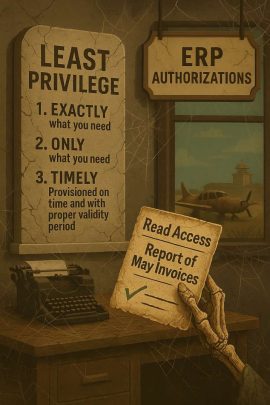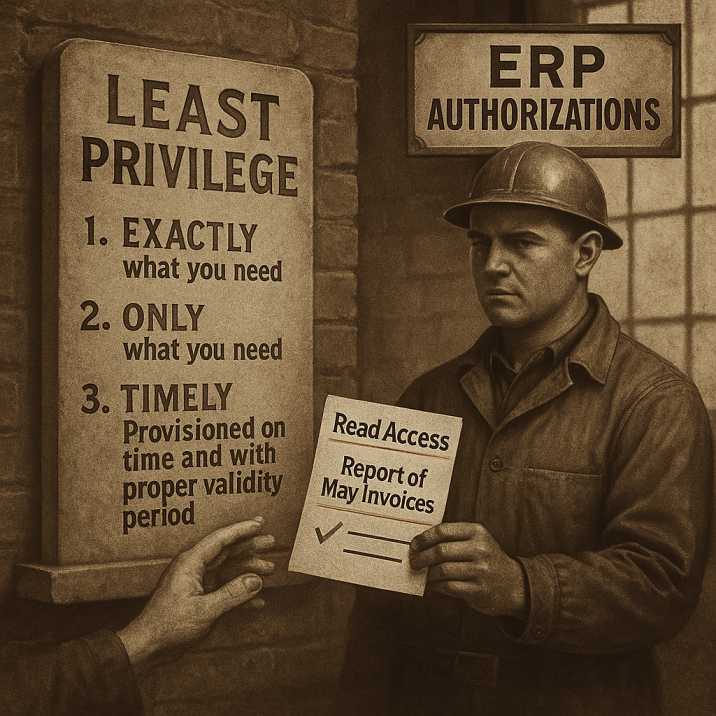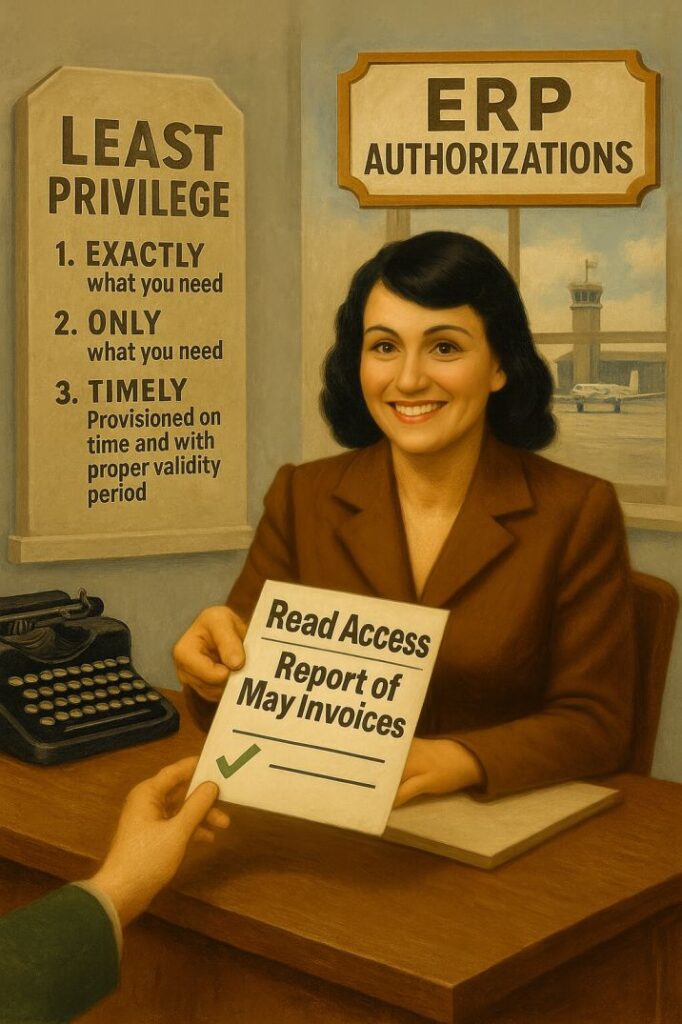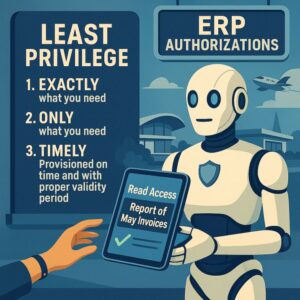
The Walking Dead of Least Privilege - A Halloween Tale for SAP Security

Chapters
Share Article
Let's Talk SAP Security
Have questions about SAP Security? We’re here to help. Contact Us
Love it or hate it — and even if we call it something else — the spirit of least privilege never truly dies. Like a good ghost story, it lingers in our systems, our policies, and our debates. Sometimes ignored, sometimes revered, sometimes reinvented — the concept is always present.
🏚️ Abandoned — The Graveyard of Least Privilege
In too many enterprises, least privilege no longer feels en vogue. The once-busy office of least privilege is empty, the friendly gatekeeper gone. Outside the window, a small airport lies abandoned, the runway cracked, a rusted-out airplane slumped in the weeds. Inside, cobwebs stretch across the corners, and the stone tablet of least privilege shows deep fissures — its commandments ignored, its authority eroded.

Those commandments were always simple, timeless, and clear:
1. Exactly what you need
2. Only what you need
3. Provided on time, with a proper validity period
But in today’s enterprises, these rules are too often violated. Permissions sprawl unchecked, long-forgotten accounts remain active, and admin rights float like ghosts through every corridor of the enterprise. Least privilege hasn’t died — it’s been neglected, abandoned, left to rot.
A skeletal outline is perfect for a Halloween blog — after all, who doesn’t love a little bone-chilling suspense? 🎃💀 But don’t worry, this won’t be a graveyard of half-baked ideas. Let’s flesh it out and dig up the story of least privilege: the good, the bad, and the ugly across its many lifetimes.
🧮 Bean Counter — The Paper Ledger Era (Pre-SAP)
Before screens and systems, least privilege lived in ink. Under a wooden shingle marked General Ledger, a meticulous clerk guarded a thick book chained to the desk. Entries were handwritten, and pages were numbered to prevent “creative additions.” Nothing left the room without a reason, and every report request was metered out like rations — the minimum necessary to do the job.
Controls were simple, physical, and effective: read under supervision, post only with a countersignature, lock the ledger each night, separate who prepares from who approves — the four-eyes principle long before anyone coined “SoD.” The bean counter wasn’t a villain; he was the gatekeeper of accuracy. Even the ambience nodded to restraint: the crisp ruled lines felt like bars on a window, and at closing time the book thudded shut with a finality any midnight auditor would respect.

The stone tablet of least privilege was here too — older than silicon, older than software — repeating the same commandments: Exactly what you need. Only what you need. Provided on time. Later, we would encode these instincts into SAP as authorization objects, roles, and segregation-of-duties rules; but the discipline itself predates computers. Least privilege didn’t start in IT — IT simply inherited it.
🏭 Industrial Era — Shadows on the Factory Line
By the 1970s and 80s, the ledger gave way to terminals and batch jobs. SAP R/2 emerged in the mainframe era, built for industrial-scale enterprises that valued efficiency, repeatability, and control. Least privilege here wasn’t a matter of who could open the book — it was about which worker could run which transaction on the line.

Picture a foreman in coveralls, walking the length of a factory floor. Each worker is assigned a single task, repeated day after day. Tools are checked in and checked out, raw materials rationed, and machine time scheduled. That was SAP access with least privilege in the R/2 and early R/3 days: permissions were stamped out like widgets, tied tightly to transactions, batch processes, and predictable roles.
The stone tablet of least privilege was mounted on a soot-darkened wall like a factory regulation: Exactly what you need. Only what you need. Provided on time. It felt more like a safety poster than a policy, but the principle was the same. There’s something haunting in the uniformity — access controlled not by personality, but by process. Predictable, efficient, and a little impersonal, least privilege in this industrial age was less a conversation with a gatekeeper and more a rule carved into the machinery itself.
📎 50s Secretary — The Golden Age of Control (Early 2000s)
Step back to the “good old days” of SAP — for me, that means the early 2000s. I like to imagine it as a 1950s Hollywood-style office, where least privilege was alive and well by both design and necessity.
A busy assistant manages the typewriter and the flow of information — each click-clack of the keys like a rattling chain keeping the data locked in place — handing out the Report of May Invoices only on a need-to-know basis. In the same way, SAP’s SID-based architecture of that era kept systems predictable. Data was available, but only if you knew your way around, and access was tightly governed through the ABAP Authorization Concept in the application layer. Outside the office window, a small airport might hum with mid-century energy.
I think of this as departures to new destinations — the beginnings of the cloud era. Back in the early 2000s, it was simpler: access was tied to which SID you needed, whether R/3, ECC, CRM, SRM, BW, or HR.

Today we struggle to navigate all the cloud-based jargon — BTP, RISE, GROW, and more — but at the time, least privilege was still grounded in predictable, mission-specific systems. And always present was the stone tablet of least privilege, reimagined with a 1950s aesthetic but carrying the same timeless commandments: Exactly what you need. Only what you need. Provided on time. Its words felt as if etched not just in granite but on a tombstone — rules that refused to die. The assistant with the invoice report wasn’t a roadblock; she was the trusted gatekeeper who kept things moving. If you needed access, you asked, you waited, and you received exactly what was appropriate — no more, no less. It was, in hindsight, a golden age of least privilege: orderly, dependable, and woven into the rhythm of work life.
🚀 Futuristic — The Digital Resurrection
Step into a world where the old and the new blur together. The stone tablet of least privilege still exists, but now it glows across a digital dashboard — timeless rules projected on LED panels. The permission slip hasn’t vanished, it’s transformed: an ephemeral token of access that appears on demand, expires automatically, and leaves no lingering copy behind… only the forever-haunting audit trail.

The broker is no longer a clerk or a foreman but a machine intelligence — a humanoid robot, or perhaps today’s Generative AI models. Friendly in tone but precise in execution, it listens to requests, interprets context, and grants exactly what you need, only what you need, provided on time. The emphasis has shifted: while the restraint of “least” and “only” still matters, what feels most powerful in this era is the guarantee that you receive exactly what you need, exactly when you need it.
Least privilege becomes less about denial and more about precision, speed, and relevance.
The Jetsons-style backdrop now represents the modern cloud-based architecture. The old SIDs are fading away, replaced by BTP services and subscriptions. And beneath the glossy skyline, the quiet hum of algorithms carries a dual note — ominous and exciting at the same time. It’s both hopeful and haunting, a reminder that even in the age of AI, least privilege isn’t dead. It has simply been resurrected in digital form, glowing brighter than ever.
👻 The Friendly Ghost of Least Privilege
Least privilege never truly dies. It lingers in every enterprise — sometimes abandoned, sometimes respected, sometimes reinvented.
We can bury the term, rename it, or claim we’ve moved beyond it. But like every good Halloween tale, least privilege always claws its way back from the grave.
And yet, its meaning evolves. In the past, the focus was on restriction — least, only, deny by default. But today, the greater value lies in precision and timeliness: giving users exactly what they need, exactly when they need it — nothing more, but also nothing less. That balance is where security and productivity meet.
The only real question is: when it returns to haunt your systems… will you be ready to answer the knock at the door? 🚪🎃
About the author:
 Barry Snow has been working in the corporate IT industry since 1996, and has focused his IT career on SAP in 2006. His top SAP passions are Master Data, Cybersecurity, and Training. Barry has broad cross-module exposure in both SAP Security and the SAP Data Mgmt disciplines. In the past 7 years, he has consulted globally on over 35 implementations of SAP Security solutions.
Barry Snow has been working in the corporate IT industry since 1996, and has focused his IT career on SAP in 2006. His top SAP passions are Master Data, Cybersecurity, and Training. Barry has broad cross-module exposure in both SAP Security and the SAP Data Mgmt disciplines. In the past 7 years, he has consulted globally on over 35 implementations of SAP Security solutions.
He is a regular content creator in the SAP Community on LinkedIn and a Pre-Sales Solution Engineer and Technical Account Manager at SecurityBridge.

